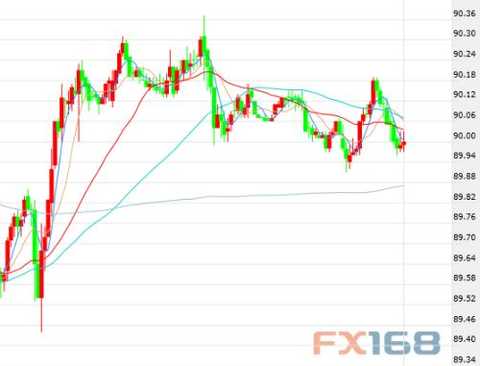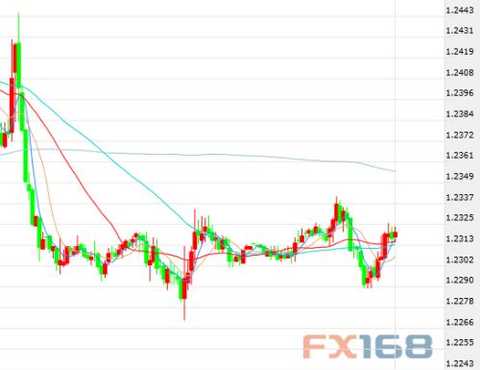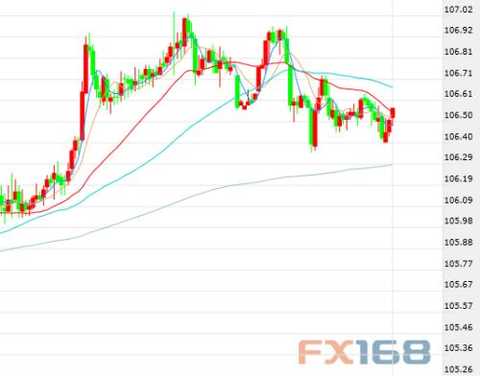The dollar retreated to the 90th mark and waited for the first "mine" to detonate the gold plunge soon?
On Monday (March 12), the US dollar index was trading below the 90 mark, waiting for the first heavy “mine†to detonate this week. As the dollar weakened, the major non-US currencies led by the euro and the yen rose, while spot gold did not perform well and failed to benefit from the dollar's fall. Technically, some analysts pointed out that gold is building a double top and is likely to fall afterwards.
The dollar waits for the first heavyweight data this week to test the euro and the yen
In the US market, the US dollar index oscillated lower and traded below the 90 mark. The market waited for the US heavy data and the latest progress of the Trump trade tax.

(US dollar index 30 minutes chart, source: FX168 Financial Network
After the announcement of the February non-farm payrolls report in the United States on the previous trading day, the US dollar index once surged to 90.37 in the short-term, but then quickly retraced from that point. Although the growth of the non-agricultural employment in the United States has been greatly improved, the salary increase has unexpectedly slowed down. The US dollar remained moderately under pressure on this trading day, but the volatility was small.
This week, the US will release the latest inflation data - the US February Consumer Price Index (CPI), the last inflation report before the Fed's March meeting, and retail sales news. After Canada, Mexico, and Australia, the market is concerned about which countries and regions will receive US tariff exemptions.
This week, anti-measures against the Trump tariff measures of the EU and other countries are expected to continue to attract market attention. It is expected that there will be no comprehensive trade war, but it will still put pressure on the US dollar.
After unexpectedly strong job growth in the US failed to bring inflationary pressures in February, investors will focus on this Tuesday's CPI report, and data performance may have a significant impact on the Federal Reserve's (FED) rate hike expectations during the year, which may trigger foreign exchange markets. Drastic fluctuations.
According to Sina's quotation from foreign media, the cost of living in the United States is still rising, only slower than the beginning of the year. The median forecast of the Bloomberg survey shows that consumer prices were expected to rise 0.2% from the previous month, while January's gains were the biggest since September last year, and the Labor Department will release official data on Tuesday. Even so, the continued rise in prices will still constitute a key reason for the Fed's decision-making, and the market widely expects the Fed to raise interest rates at the March 21 meeting.
At present, the market almost believes that the Fed will raise interest rates on March 21, and expects to raise interest rates twice thereafter. The estimate of three interest rate increases is consistent with the Fed's own thinking. However, some Wall Street investment banks have already speculated that the Fed may raise interest rates four or even five times this year. Once the CPI data is strong, it may prompt traders to expect the Fed to raise interest rate forecasts.
From a technical point of view, the index rebounds in the middle of the Bollinger Band or indicates that the callback is over. It will resume this wave of rebound since March 7. If it meets expectations and resumes its upward trend, the initial resistance is still at 90.20, and the breakthrough will open further strength. 90.50.
However, if the fall falls below 89.90, the short-term bullish expectations will be broken, and the next down may point to the 89.75 and 89.60 levels. However, from the current point of view, the US dollar is still expected to challenge the psychological barrier that falls below 90.
EUR/USD hit a high of 1.2341 on Monday and then fell back. After a strong start in 2018, the euro was still below the three-year high of 1.2556 hit in February.

(Euro/US Dollar 30 Minute Chart, Source: FX168 Financial Network)
The euro fell last week as the European Central Bank said inflation expectations are still weak and monetary policy will remain "reactive."
"The euro is still affected after the ECB meeting," said Alvin Tan, an analyst at Societe Generale. “The crossover trend is affecting the euro.â€
Bank of America Merrill Lynch (BofAML) analysts pointed out that the bank's capital flow shows that the liquidity of the euro in recent weeks also reflects the liquidity of the dollar. Hedge funds and real currencies have shorted the euro in recent weeks, while official institutions and companies are doing more euros. This trend of movement explains why the EUR/USD maintains range volatility. At the same time, the current market's cumulative position on the euro is only a “slightly long†euro, indicating that the uncertainty of the future trend of the euro/dollar may be upwards or downwards.
Since there is little economic data in Europe, traders will focus on the euro zone finance ministers meeting on Monday to discuss remarks about trade protectionism after President Trump decided to impose some tariffs.
Many analysts are still optimistic about the euro.
"The euro will not fluctuate particularly because the current account surplus in the euro zone is 3.5% of GDP, so we think it will be difficult for fiscal officials in the euro zone to push down the euro," said Viraj Patel, currency strategist at ING.
In terms of the yen, the USD/JPY volatility was the most volatile on the trading day. The exchange rate rose to 106.97 earlier in the session, but then it plunged sharply, showing a sharp shock and retracement, and the intraday gains in the Japanese stock market also narrowed.

(USD/JPY 30-minute chart, source: FX168 Financial Network)
In the day, Abe Shinzo, a member of the ruling Liberal Democratic Party, said that he had received a report from the Ministry of Finance and admitted that the documents selling public land to some private schools had been tampered with.
The media said on Monday that the name of the wife of Japanese Prime Minister Shinzo Abe was removed from the document on the issue, due to increased pressure on the Prime Minister and his allies, Finance Minister Aso, to cover up the truth.
Abe denied that he or his wife had helped a school operator and said he would resign if there is evidence that they have evidence. Aso has apologized for the behavior of his department on the document, but said he did not intend to resign.
Due to market concerns that the scandal may cause Abe's economic stimulus plan to be blocked, the yen weakened, and the USD/JPY fell reversed slightly earlier, hitting a low of 106.35, while the exchange rate rose 0.1% earlier.
Market analysts pointed out that the scandal between Japanese Prime Minister Shinzo Abe and the private school has escalated and may become a potential threat to the Abe regime and its stimulus policies.
Market participants said that Japan’s political development helped ease the gains in the Japanese stock market and provided some support for the yen.
Masashi Murata, currency strategist at Brown Brothers Harriman, said that the theme of the 2018 deal was the risk of the USD/JPY breaking 100. From a fundamental point of view, the exchange rate breakthrough is not an extreme situation.
The USD/JPY exchange rate has mostly shown a downward trend this year, and on March 2 it touched the key support level of 105. "There is no strong support after 105, so once the dollar/yen starts to fall, the rate of decline will be very fast," BBH's Murata said.
Gold continues to be sluggish and technically fascinating.
Spot gold fell on Monday, hitting a low of $1315.00 per ounce, which was under pressure as the stock market strengthened. The latest US employment report has eased concerns about inflation and the US rate hike, boosting global risk appetite.

(Spot gold 30 minutes chart, source: FX168 financial network)
"The rebound in the stock market has weakened some of the precious metals. There is not much money flowing into gold," a trader based in Hong Kong said.
The US non-farm payrolls data released on Friday showed that the non-agricultural employment population increased by 313,000 last month, but inflation concerns subsided, but the average hourly wage growth fell to 2.6%.
Asian stock markets generally rebounded on Monday after the employment report was released.
Money market traders insist that the Fed raises interest rates three times this year, and the probability of raising interest rates four times this year is only one-fourth.
“The labor report we saw on Friday has spread to this week... The slowdown in wage growth last month has certainly eased concerns about a more aggressive rate hike,†said ANZ analyst Daniel Hynes.
Inflation concerns usually boost gold, and gold is seen as a safe haven for gold prices. But the Fed may raise interest rates to fight inflation, which makes gold less attractive because it does not bring interest income.
"We still have doubts about the short-term prospects of gold, because we suspect that the price of gold will struggle due to the strength of the dollar, and we expect the dollar to start rising near the next time (the next time the Fed meeting)." INTL FCStone analyst Edward Meir in a report Said in the middle.
On the technical side, the outlook for gold is not optimistic. Analyst Damon Verial believes that the gold price on the technical side is forming a double top, and then a large probability will fall. The dollar's market outlook is unclear, and seasonal factors indicate that the price of gold is likely to fall sharply in March.
Verial believes that whether it is technical, dollar or other influencing factors, investors may be prepared to wait for the price of gold to fall.
From the trend of SPDR Gold ETF (GLD), GLD is forming a double top pattern. The historical trend before the study can show how the gold market will fluctuate afterwards.
Verial pointed out that after GLD came out of this pattern, the market will have an average decline of 3.5%, and the current trend is to fall to around $121.3.
Verial believes that GLD is currently more likely to fall, with a probability of a rise of only 4.1%, but the probability of a decline is only 13.3%. Almost every time there was a big drop in GLD, there was almost a double top pattern.
After the last GLD formed a double top, it eventually fell into a consolidation state. But five times before this, every price has dropped sharply.
This shows that the appearance of the double top form means that there is a big chance for the bears.
Faux Leather for contract, contract vinyl, pvc leather for contract
Contract Vinyl,Contract Vinyl For Seats,Synthetic Leather For Contract,Artfical Leather For Contract
Vigor Plus Co., Ltd , https://www.vigorplusx.com
